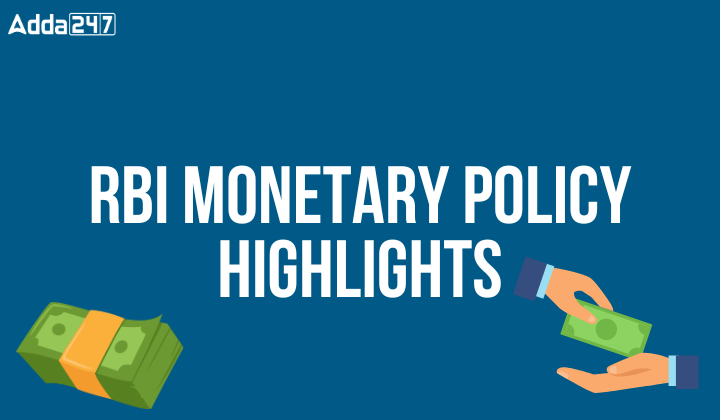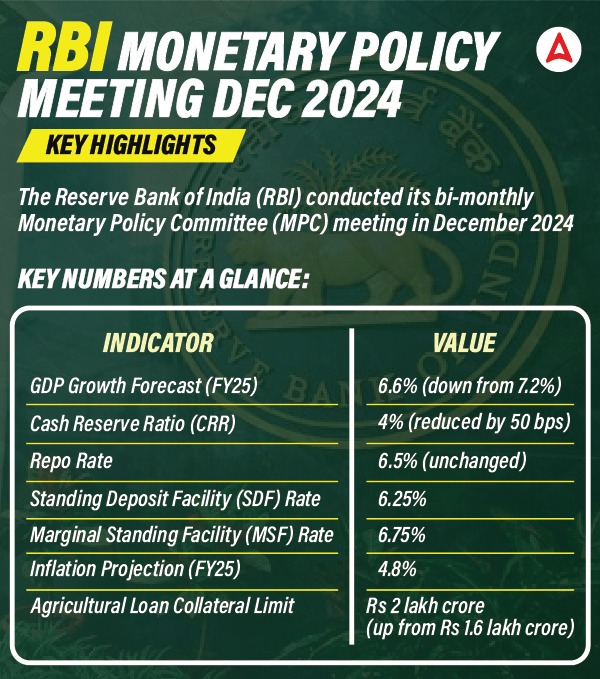Table of Contents
The Reserve Bank of India Monetary Policy Committee, chaired by Governor Shaktikanta Das, unveiled several significant policy updates during its December 2024 meeting. These measures reflect a balanced approach to tackling inflation and bolstering economic growth while addressing liquidity in the banking system.
The Reserve Bank of India decided to keep policy interest rates and its monetary stance unchanged with the benchmark interest rates at 6.5% by a 4:2 majority. The given article presents some of the key highlights of the RBI Monetary Policy Meeting 2024 and also explains some terms associated with it.
RBI Monetary Policy Meeting 2024
The RBI Monetary Policy Meeting 2024 highlights the RBI’s calibrated approach to navigate a challenging economic landscape while prioritizing financial stability and growth.
Repo Rate Unchanged
- The MPC, by a 4:2 majority, decided to retain the repo rate at 6.5%, maintaining the stance of “withdrawal of accommodation.”
- The decision underscores the need to monitor inflation trends and economic conditions.
Cash Reserve Ratio (CRR) Cut
- The CRR has been reduced by 50 basis points, bringing it down to 4%, effective immediately.
- This move will inject ₹1.16 trillion into the banking system, enhancing liquidity and supporting credit availability.
Revised GDP Growth Forecast
- The GDP growth projection for FY25 has been revised downward to 6.6% from the earlier estimate of 7.2%.
- This adjustment reflects global uncertainties and domestic economic challenges.
Inflation Forecast Adjustments
- CPI inflation expectations for FY25 have been revised upward to 4.8% from the earlier 4.5%.
- Governor Das emphasized the importance of vigilance in monitoring food price shocks and supply-side disruptions.
Liquidity Management Measures
- The reduction in CRR is aimed at improving banking sector liquidity, facilitating smoother credit flow to businesses and consumers.
Macro-Economic Outlook
- Governor Das highlighted the need for sustained policy interventions to ensure price stability while fostering economic resilience amidst global headwinds.
- The central bank remains committed to achieving its medium-term inflation target of 4%.
What is Monetary Policy?
Monetary policy pertains to the strategy adopted by the central bank concerning the utilization of monetary tools at its disposal to accomplish the objectives outlined in the legislation. The primary goal of the RBI’s monetary policy is to uphold price stability while also taking into account the aim of promoting economic growth.
- Ensuring price stability is an essential precondition for achieving sustainable growth.
The amended RBI Act of 1934 also includes provisions for the Government of India, in consultation with the Reserve Bank, to establish the inflation target (4% +-2%) once every five years.
Monetary Policy Committee
Under Section 45ZB of the revised RBI Act, 1934, the central government has the authority to form a six-member MPC tasked with determining the policy interest rate necessary to meet the inflation target. The first MPC was established on 29 September 2016.
The Monetary Policy Committee (MPC) of the Reserve Bank of India (RBI) will meet to formulate its response to the Government of India regarding the elevated level of inflation in the nation.
Members of the Monetary Policy Committee
MPC consists of six members, the governor of RBI is the Chairperson of MPC, the Deputy Governor of RBI is in charge of Monetary Policy, one member is nominated by the Board of RBI, and three members are appointed by the Central Government.
| Monetary Policy Committee | |
| Chairperson (Governer of RBI) | Sri Shaktikanta Das |
| In-charge of Monetary Policy (Deputy Gov. of RBI) | Dr. Michael D. Patra |
| Member 1 (Nominated by Central Board of RBI) | Dr. Rajiv Ranjan |
| Member 2 | Ram Singh |
| Member 3 | Dr. Nagesh Kumar |
| Member 4 | Saugata Bhattacharya |
RBI Monetary Policy 2024: Key Highlights
The table below presents some key highlights of the monetary policy committee review meeting held in December 2024.
| Key Highlights of the MPC Meeting | |
| Repo Rate | 6.50% |
| Reverse Repo Rate | 3.35% |
| Standing Deposit Facility (SDF) | 6.25% |
| Marginal Standing Facility (MSF) | 6.75% |
| Bank Rate | 6.75% |
| Cash Reserve Ratio (CRR) | 4% |
| Statutory Liquidity Ratio (SLR) | 18.0% |
| GDP Growth Forecast(FY25) | 6.6% |
| Inflation Projection(FY25) | 4.8% |
| Agricultural Loan Collateral Limit | Rs. 2 Lakh Crore |
Some Important Terms Related to Monetary Policy
Here will understand the definition of some important tools of Monetary Policy such as the Repo Rate, SLR, SDF, CRR, etc. The table below provides some basic definitions of terms related to RBI Monetary Policy.
| Definitions of Terms Related to Monetary Policy | |
| Repo Rate | The interest rate at which the Reserve Bank offers short-term/overnight funding to banks using government and other authorized securities as collateral through the liquidity adjustment facility (LAF). |
| Reverse Repo Rate | The interest rate at which the Reserve Bank withdraws excess liquidity from banks overnight, using eligible government securities as collateral through the liquidity adjustment facility (LAF). |
| Marginal Standing Facility (MSF) |
It is a rate at which banks can borrow overnight funds from RBI by furnishing authorized Govt. Securities.
|
| Statutory Liquidity Ratio (SLR) | The proportion of Net Demand and Time Liabilities (NDTL) that a bank must hold in secure and readily convertible assets, including unencumbered government securities, cash, and gold. Alterations in SLR frequently impact the amount of funds available within the banking system for lending to private enterprises. |
| Bank Rate | The Bank Rate signifies the rate at which the RBI is prepared to purchase or rediscount bills of exchange or other commercial papers. It is disclosed in accordance with Section 49 of the RBI Act, 1934. |
| Cash Reserve Ratio (CRR) | The average daily balance that a bank must uphold with the Reserve Bank, expressed as a percentage of its Net Demand and Time Liabilities (NDTL), as stipulated by notifications published in the Gazette of India. |





 GA Capsule for SBI Clerk Mains 2025, Dow...
GA Capsule for SBI Clerk Mains 2025, Dow...
 The Hindu Review October 2022: Download ...
The Hindu Review October 2022: Download ...
 Mahatransco Recruitment 2025 Notificatio...
Mahatransco Recruitment 2025 Notificatio...


